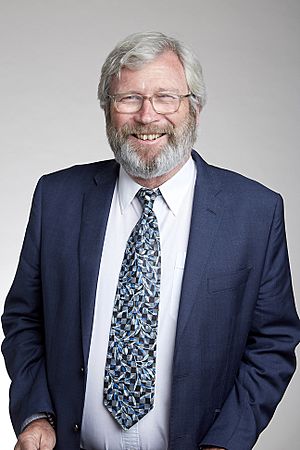Gerard J. Milburn facts for kids
Quick facts for kids
Gerard Milburn
|
|
|---|---|

Gerard Milburn at the Royal Society admissions day in London, July 2017
|
|
| Born |
Gerard James Milburn
1958 (age 66–67) Brisbane, Queensland, Australia
|
| Nationality | Australian |
| Alma mater |
|
| Known for |
|
| Scientific career | |
| Fields | Physicist |
| Institutions |
|
| Doctoral advisor | Daniel Frank Walls |
| Doctoral students | Howard M. Wiseman |
Gerard James Milburn (born 1958) is an Australian scientist. He is a theoretical quantum physicist. This means he studies the very tiny world of atoms and particles. He uses math and ideas to understand how things work at this super small level. He is well-known for his work on how to control quantum systems. He also studies how we measure things in the quantum world. His research helps us understand quantum information and how to build quantum computers.
Contents
Studying Physics
Gerard Milburn started his science journey in Australia.
- In 1980, he earned his first degree in Physics from Griffith University.
- He then moved to New Zealand to continue his studies.
- In 1982, he completed his PhD, which is a high-level university degree. He studied physics at the University of Waikato.
- His PhD research was about "Squeezed States and Quantum Nondemolition Measurements." This sounds complex, but it's about special ways to look at tiny particles without changing them.
His Science Career
After getting his PhD, Dr. Milburn continued his research.
- In 1983, he did advanced research at Imperial College London in the UK. This is called postdoctoral research.
- In 1984, he received a special award called a Royal Society Fellowship. This allowed him to work with another famous scientist, Peter Knight. They worked on quantum optics, which is how light behaves at the quantum level.
Returning to Australia
- In 1985, Dr. Milburn came back to Australia. He became a lecturer at The Australian National University. A lecturer teaches university students.
- In 1988, he moved to The University of Queensland. He became a "Reader" in Theoretical Physics. This is like a senior teacher and researcher.
- By 1994, he became a full Professor of Physics.
- In 1996, he became the Head of the Physics Department at the university.
Leading Research
- From 2000 to 2010, Dr. Milburn helped lead a big research center. It was called the Australian Research Council Centre of Excellence for Quantum Computer Technology. This center focused on creating new quantum computers.
- From 2003 to 2013, he was an Australian Research Council Federation Fellow. This is a special research position for top scientists.
- He also gave advice to important science groups. He was on the advisory committee for the Institute for Quantum Computing. He also advised the Perimeter Institute for Theoretical Physics. These are big centers for quantum science.
- From 2011 to 2017, he was the Director of another major research center. This was the Australian Research Council Centre of Excellence for Engineered Quantum Systems.
Awards and Recognition
Dr. Milburn has received many awards for his important work.
- In 2001, he won the Moyal Medal for Mathematical Physics.
- In 2003, he received the Boas Medal.
- He is also a member of several important science groups:
- He became a Fellow of the Australian Academy of Science in 1999.
- He became a Fellow of the American Physical Society in 2005.
- In 2017, he was elected a Fellow of the Royal Society. This is a very old and respected science group in the UK. Being a Fellow means you are recognized as a leading scientist.

All content from Kiddle encyclopedia articles (including the article images and facts) can be freely used under Attribution-ShareAlike license, unless stated otherwise. Cite this article:
Gerard J. Milburn Facts for Kids. Kiddle Encyclopedia.
